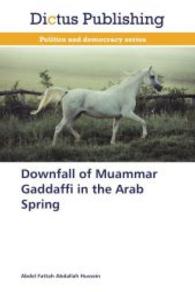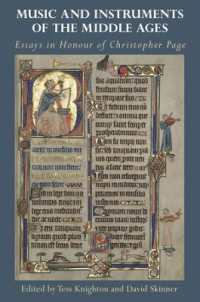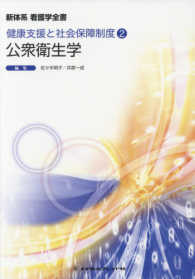- ホーム
- > 洋書
- > 英文書
- > History / World
Full Description
Between the 3rd and 2nd Millennia BC: Exploring Cultural Diversity and Change in Late Prehistoric Communities is a collection of studies on the cultural reconfigurations that occurred in western Europe between the 3rd and 2nd millennia BC. It brings together seven texts focusing on the evidence from the West of the Iberian Peninsula, and one on the South of England. The texts have their origin in a landmark meeting held at the University of Coimbra in November 2018, where scholars explored the grand narratives explaining the differences between what are traditionally considered Chalcolithic (or Late Neolithic) and Bronze Age communities. The contributions look at key aspects of these grand narratives through regional perspectives, asking the following questions: is there clear data to support the idea of an intensification of social complexity towards the emergence of the Bronze Age chiefdoms? What is the role of monumental architecture within this process? How do we best discuss the different levels of architectural visibility during this period? How can we interpret collective and individual burials in relation to the emergence of individual/territorial powers? In answering these questions, the papers explore regional diversity and argue that regional specificities resist a general interpretation of the historical process at stake. In light of this resistance, the book emphasizes that cultural singularities only become visible through contextual, medium, or low-scale approaches. The recognition of singularities challenges grand narratives, but also carries the potential to expand our understanding of the changes that occurred during this key moment of Late Prehistory. The book thus offers readers the opportunity to think about the diversity of archaeological evidence in combination with an exploration of the available range of approaches and narratives. The critical intertwining of multiple points of view is necessary, because it gets us closer to how elusive the cultural differences of prehistoric communities can be. This elusive dimension is precisely what can force us to constantly rethink what we see and what questions we ask.
Contents
Chapter 1: Introduction: The Turning of Things - Susana Soares Lopes and Sérgio Alexandre Gomes ;
Chapter 2: The Northwest Iberian Peninsula Between the Late 3rd Millennium and Early 2nd Millennium BCE as a Mosaic of Cultural Identities - Ana M.S. Bettencourt ;
Chapter 3: On Identity and Otherness Reshaping the Dynamics of Late Prehistoric Art Traditions in Northern Portugal - Lara Bacelar Alves ;
Chapter 4: The Site of Areias Altas (Porto, Portugal): Current Knowledge of its Occupation in the first Half of the 2nd Millennium BC - Sara Luz ;
Chapter 5: Searching for the Turning Point to Bronze Age Societies in Southern Portugal: Topics For A Debate - Joaquina Soares ;
Chapter 6: 'Death in the Occident Express': Social Breakdown in Southwestern Iberia at the End of the 3rd Millennium BC - António Carlos Valera ;
Chapter 7: A Slow Awakening on the Plain: The Bronze Age in the Beja Region (South Portugal) - Miguel Serra ;
Chapter 8: Human/Animal Interactions at the Turn of the 3rd to the 2nd Millennium BC. Zooarchaeological Data from Inner Alentejo, Portugal - Cláudia Costa ;
Chapter 9: Situated Knowledge and Early Bronze Age Occupation at Must Farm, Cambridgeshire - Lesley McFadyen







